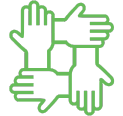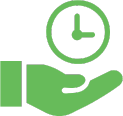PROJECT OVERVIEW
BrewCo was losing retail candidates at twice the industry’s drop-off rate, with many quitting early or opting for a faster competitor. The result? Staffing gaps, negative feedback, and serious strain on the candidate experience.
Complaints of unresponsiveness and poor retention made it harder to attract top talent — threatening workforce stability and weakening BrewCo’s employer brand.
I discovered there was no consistent hiring process across the retail network — no shared baseline, no central record, and scattered feedback about what worked (or didn’t).
What was breaking down in the candidate experience?
How could we redesign hiring to be faster, more candidate-centered, and aligned with BrewCo’s brand promise?
To explore this, I led research around four strategic aims:
🎯 Build a Scalable Research Foundation
Create a single source of truth to support hiring across BrewCo's retail network.
🎯 Aligning Stakeholders on Candidate Needs
Drive decisions using real candidate pain points to prioritize key improvements.
🎯 Secure Cross-Functional Buy-In
Translate user needs and process gaps into organization-wide commitment and resources.
🎯 Elevate BrewCo's Employer Brand
Reframe hiring as a brand experience aligned with BrewCo’s customer-first values.

Budget
$1M

Team
Lead UX Researcher, 1 Lead UX Designer
1 TA Partner, 2 Hiring Managers
1 Senior HR, 1 Onboarding Specialist

Timeline
3 months
Research Goals & Approach
RG1: Pinpoint early attrition points in the current hiring journey to uncover root causes and improve retention.
RG2: Reveal gaps between candidate expectations and the current hiring journey to surface pain points and uncover opportunity areas.
RG3: Map the end-to-end retail hiring journey to build a unified framework grounded in candidate mental models and aligned across teams.
Stakeholder Interviews
Requirements Gathering
Baseline Mapping Structure
Assumptive Mapping Workshop
18 1:1 Interviews
Surveys
Desirability Matrix
Thematic Analysis
Hiring Experience Map
Internal & External Stakeholder Presentations
⚙️Process | 📦 Artifacts ▸
Intent
Synthesised fragmented hiring data across sources to visualize the current journey- surfacing knowns, unknowns, and systemic breakdowns.
⚙️ Mapped the hiring experience by synthesizing input from recruiters, candidates, and stakeholders to uncover hidden touchpoints and pain points.
📦 As-Is Assumptive Map v0
⚙️Process | 📦 Artifacts ▸
Intent
Created a collaborative space for the cross-functional team to challenge assumptions, surface insights, and align on the current hiring journey.
⚙️ Facilitated a design thinking workshop to co-create a detailed swim-lane journey map, breaking down silos and aligning the team.
📦 As-Is Assumptive Map
⚙️Process | 📦 Artifacts ▸
Intent
Building on knowledge gaps uncovered during the workshop, I used a mixed-methods approach to gather candidate feedback. Interviews captured rich behavioral insights, while surveys validated themes and expectations at scale.
⚙️ Conducted 18 semi-structured 1:1 candidate interviews to validate the assumptive map. Follow-up surveys and desirability matrices quantified candidate expectations and surfaced knowledge gaps.
⚙️ Applied affinity mapping to synthesize qualitative data, revealing critical friction points within the candidate experience.
📦 Interview Guide, Survey, Desirability Matrix, Thematic Analysis
⚙️Process | 📦 Artifacts ▸
Intent
Synthesized research into a final hiring journey map that revealed short- and long-term opportunities grounded in user pain points, mental models, and behaviors. This showcased UX Research’s strategic role in driving both process and digital transformation to senior leadership.
⚙️ Led cross-org walkthroughs to translate research findings into feasible, aligned design solutions. This laid the foundation for a unified hiring process.
📦 Experience Map, Presentations
Challenges
Positioned research to expose critical gaps, unite teams, and shape the hiring roadmap.
Aligned research insights to KPIs (drop-offs, offer declines), converting them into business priorities that reduced churn.
Mapped candidate mental models to reveal drop-offs and gaps—validating the need for empathetic design.
Built a shared journey-mapping framework to align teams, reduce friction, and streamline hiring—improving clarity and speed.
When applying, I’m in a flow, and I'm tired. If the form is too long or buggy, I just give up — on to the next.
– Candidate 2
Key Discoveries
Application overwhelm & team blindspots
Insight 1: Candidates reach the application overwhelmed and low on patience—yet teams expect time, energy, and tolerance for friction. ▸
- The application is the critical midpoint of the candidate’s journey.
- Long or buggy forms break momentum, especially on the go.
- Interruptions cause a permanent drop-off.
Solution 1: Simplify and streamline application flow to reduce effort, prevent errors, and enable faster completion.
Early-stage abandonment & friction triggers
Insight 2: Early abandonment happens when posts feel outdated, navigation confuses users, and application starts are complex. ▸
- Outdated or inaccurate postings erode trust and drive drop-off.
- Candidates arrive at applications emotionally taxed.
- Lengthy or glitchy forms break momentum and increase abandonment.
Solution 2: Indicate job postings are up-to-date, simplify navigation, and ease application start. ▸
- Show only active job posts with clear details (must-haves, differentiators, personal fit) to build trust.
- Ease application start by simplifying account creation steps.
- Simplify navigation to maintain momentum and reduce unnecessary friction.
Communication neglect leads to offer loss
Insight 3: When updates stall or next steps aren’t clear, candidates feel ignored, lose interest, and accept competing offers. ▸
- Silence after 10 days post-application signals rejection to most candidates
- Delays over 7 days post-interview cause candidates to default to the next competing offer.
Solution 3: Set clear timelines and close communication gaps to prevent candidate drop-off. ▸
- Set timeline expectations at each stage.
- Send timely updates via email or applicant portals.
- Close the loop fast to reduce uncertainty.
How candidates search and select job listings
Insight 4: Candidates follow a sequential search-to-filter strategy when evaluating job listings. ▸
They scan for:
- Must-haves (role, location)
- Key differentiators (wage, recency, brand)
- Personal fit (flexibility, benefits)
Solution 4: Reorder job posting content to match how candidates evaluate listings. ▸
- Surface must haves first (e.g., role and location).
- Introduce key differentiators (e.g., compensation and recency).
- Highlight personal-fit cues early (e.g., flexibility) .
Candidates' mental model discovery
Insight 5: Candidates' experience nested loops at each hiring stage, not a simple linear journey. They move forward only when a key moment triggers their progress. ▸
The 5 key moments that shaped candidates’ mental model of the hiring journey:
- Discovering a relevant job opportunity
- Completing and submitting the application
- Receiving timely communication updates
- Participating in the interview process
- Receiving a timely offer
Solution 5: Design key moments to reduce effort, ease decisions, and remove blockers - so candidates keep moving forward. ▸
To ensure momentum:
- Minimize friction at each catalyst — reduce blockers that delay action or decisions.
- Provide clear, timely guidance — help candidates act confidently and keep progressing.
- Monitor catalyst completion — identify early drop-offs and address them through targeted improvements.
